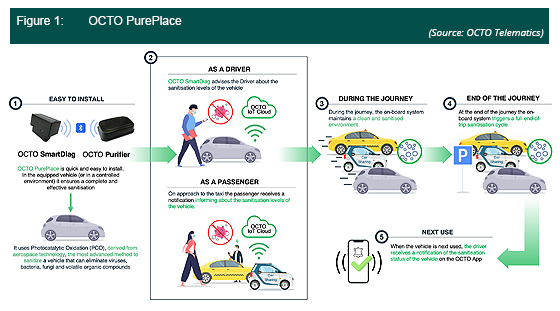Making Shared Mobility Travel Safer in the Wake of COVID-19 through Connected Sanitization
10 Jun 2020 | IN-5840
Log In to unlock this content.
You have x unlocks remaining.
This content falls outside of your subscription, but you may view up to five pieces of premium content outside of your subscription each month
You have x unlocks remaining.
10 Jun 2020 | IN-5840
OCTO Telematics Launches OCTO PurePlace |
NEWS |
Tapping into the need for higher hygiene in shared spaces, Octo Telematics recently announced a sanitization solution for shared vehicles called OCTO PurePlace. The solution consists of a purifier device (OCTO Purifier), an onboard telematics device (OCTO SmartDiag or OCTO SuperEasy), and a digital application compatible with Android and iOS. The purifier uses nanotechnology Photocatalytic Oxidation, a non-invasive technology developed by NASA, that can eliminate viruses and bacteria on surfaces and in the air to sanitize cars during and after every use. It can be connected to a car’s cigarette lighter and allows quick cleanses during a trip via intermittent self-activation and at the end of a journey with a full sanitization cycle.
 |
As shown in Figure 1, the purifier connects to the onboard telematics unit OCTO SmartDiag via Bluetooth. OCTO SmartDiag, a telematics OBD Dongle, is the key component that connects to OCTO’s Internet of Things (IoT) Cloud to inform drivers and passengers about the vehicle’s sanitization level. The solution aims to assist corporate and rental fleet companies as well as carsharing and taxi operators to adjust to the new reality and possibly longstanding impact of the COVID-19 pandemic on mobility.
The COVID-19 Impact on Mobility |
IMPACT |
Social isolation measures to contain the COVID-19 pandemic led to the halt of public life and the fear of contagion made consumers shift away from shared mobility. For instance, ride-hailing companies that have not ceased operations faced up to a 70% decrease in demand, resulting in workforce layoffs. However, as social distance rules still apply in countries exiting lockdown and should persist at least in the short term, individuals are likely to feel more vulnerable on public transportation, which should increase the search for rental and ride-hailing vehicles. Either to comply with new local norms while countries implement a gradual opening of their economies, or to improve the overall perception of safety and trust, shared mobility companies need to implement strict hygiene protocols that ensure the sanitization of their vehicles. Uber, for instance, now requires drivers and passengers to use face masks and self-certify they are taking precautions before requesting or accepting riders.
Connected services related to hygiene control, or based on voice and facial recognition to avoid contact with surfaces, will become more popular among ride-hailing, car rental, and taxi companies. Corporate fleet managers will face a similar need as they will have to assure the protection of their workforce.
Adjusting to the 'New Normal' |
RECOMMENDATIONS |
Connected sanitization solutions can help mobility companies address the changes in consumer behavior deriving from the fear of infection, which will drive hardware and software opportunities. OCTO Pure Place is an example of how the aftermarket form factor can start to fold into future trends. While OCTO Purifier is not a new product, the company was quick to transform existing hardware into a complete solution that addresses an emerging need. Similarly, aftermarket hardware companies could implement low-cost but efficient hygiene solutions that can communicate to vehicles’ telematics unity and smartphone applications. Such innovations would help these companies to mitigate the forecasted 12% drop in shipments in 2020 caused by the COVID-19 disruptions.
Meanwhile, software providers can take advantage of the increasing use of in-vehicle cameras and sensors to provide health-related use cases. Robust solutions could even use driver and occupancy monitoring systems to detect sick passengers—e.g., measure body temperature via infrared temperature sensors or identify cough and sneeze via Artificial Intelligence (AI) and Machine Learning (ML)—and alert drivers, fleet managers, and passengers about sick occupants and when vehicles requires immediate cleaning. Shared mobility companies fast to implement sanitization-related solutions are more likely to return to business and secure revenue in the upcoming months.
Related Service
- Competitive & Market Intelligence
- Executive & C-Suite
- Marketing
- Product Strategy
- Startup Leader & Founder
- Users & Implementers
Job Role
- Telco & Communications
- Hyperscalers
- Industrial & Manufacturing
- Semiconductor
- Supply Chain
- Industry & Trade Organizations
Industry
Services
Spotlights
5G, Cloud & Networks
- 5G Devices, Smartphones & Wearables
- 5G, 6G & Open RAN
- Cellular Standards & Intellectual Property Rights
- Cloud
- Enterprise Connectivity
- Space Technologies & Innovation
- Telco AI
AI & Robotics
Automotive
Bluetooth, Wi-Fi & Short Range Wireless
Cyber & Digital Security
- Citizen Digital Identity
- Digital Payment Technologies
- eSIM & SIM Solutions
- Quantum Safe Technologies
- Trusted Device Solutions
